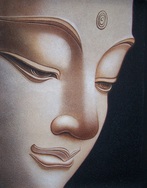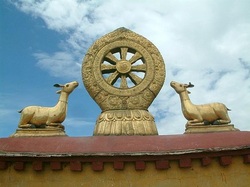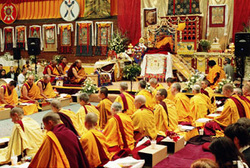The Three Jewels
The ideals at the heart of Buddhism are collectively known as the Three Jewels, or the Three Treasures. These are the Buddha, the Dharma, and the Sangha. It is by making these the central principles of one's life that one becomes a Buddhist.
The Buddha

Buddha
The Buddha refers both to the historical Buddha and to the ideal of Buddhahood which is open to all.
The Dharma

Dharma Wheel
The Dharma primarily means the teachings of the Buddha, or the truth he understood. Dharma has many meanings but most importantly it means the unmediated Truth (as experienced by the Enlightened mind) and Buddhist Teachings, the Truth as mediated by language and concepts. In the second sense Dharma is the teaching that was born when the Buddha first put his realisation into words and communicated it to others at Sarnath in Northern India. The occasion is traditionally referred to as `the first turning of the wheel of the Dharma' and the eight-spoked Dharma wheel is a common emblem of Buddhism.
As well as this Dharma, refers to the entire corpus of scriptures which are regarded as constituting the Buddhist canon. These include records of the Buddha's life (known as the Pali Canon), scriptures from a later date, and the written teachings of those people who have attained Enlightenment over the centuries. The whole canon is many hundred times as long as the Bible and it represents a literature of unparalleled riches. It includes works such as The Dhammapada, The Diamond Sutra, and The Tibetan Book of the Dead.
Another meaning of Dharma is the practices which are outlined within the scriptures. Despite the wealth of its literature the essence of Buddhism is very simple: it is finding ways to transform oneself. It could be summed up as 'learning to do good; ceasing to do evil; purifying the heart' (as theDhammapada says).
As well as this Dharma, refers to the entire corpus of scriptures which are regarded as constituting the Buddhist canon. These include records of the Buddha's life (known as the Pali Canon), scriptures from a later date, and the written teachings of those people who have attained Enlightenment over the centuries. The whole canon is many hundred times as long as the Bible and it represents a literature of unparalleled riches. It includes works such as The Dhammapada, The Diamond Sutra, and The Tibetan Book of the Dead.
Another meaning of Dharma is the practices which are outlined within the scriptures. Despite the wealth of its literature the essence of Buddhism is very simple: it is finding ways to transform oneself. It could be summed up as 'learning to do good; ceasing to do evil; purifying the heart' (as theDhammapada says).
The Sangha

The third of the `Three Jewels' is the Sangha or the spiritual community. Buddhism is not an abstract philosophy or creed; it is a way of approaching life and therefore it only has any meaning when it is embodied in people. So Buddhists place great value on the fellowship of others who are treading the same path, and those who embody its goal. In the broadest sense the Sangha means all of the Buddhists in the world and all those of the past and of the future. In practice it particularly refers to other Buddhists with whom one is in effective contact.
Buddhism being a path, some people are further advanced along it than others, and particular respect is paid to the lineage of great teachers down the millennia. Beyond this, the ideals of Buddhism find their embodiment in archetypal figures known as Bodhisattvas. For example, Avalokitesvara is the embodiment of Compassion, and he is depicted with four, eight, or a thousand arms with which he seeks to help sentient beings; Manjusri is the embodiment of Wisdom and he is depicted carrying a sword with which he cuts through ignorance. Together the Bodhisattvas and the other Enlightened teachers are known as the Arya Sangha or community of the Noble Ones.
Buddhism being a path, some people are further advanced along it than others, and particular respect is paid to the lineage of great teachers down the millennia. Beyond this, the ideals of Buddhism find their embodiment in archetypal figures known as Bodhisattvas. For example, Avalokitesvara is the embodiment of Compassion, and he is depicted with four, eight, or a thousand arms with which he seeks to help sentient beings; Manjusri is the embodiment of Wisdom and he is depicted carrying a sword with which he cuts through ignorance. Together the Bodhisattvas and the other Enlightened teachers are known as the Arya Sangha or community of the Noble Ones.
